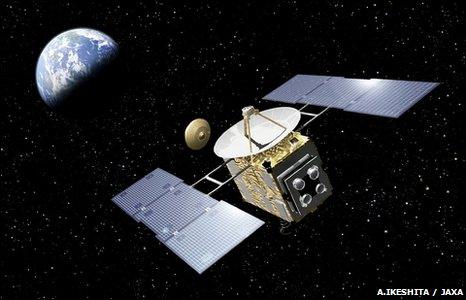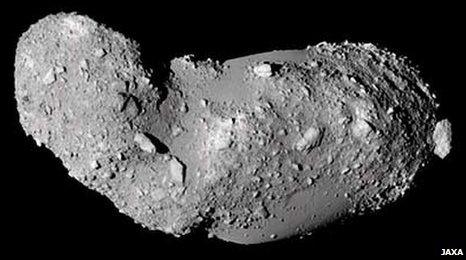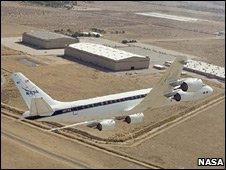Hayabusa Japanese asteroid probe aimed toward Earth
- Published

Hayabusa will release its sample capsule for a landing on Earth
The Japanese space probe Hayabusa, which was designed to return samples from an asteroid, has been placed on course for a landing in Australia.
The spacecraft is returning home from its 2005 visit to the asteroid Itokawa
Hayabusa has achieved a crucial engine firing to aim the probe at Woomera Protected Area in southern Australia.
Its sample return capsule is scheduled to detach from its "mothership" and land at Woomera on 13 June, but there is no guarantee of mission success.
It remains doubtful whether the probe managed to grab any material from Itokawa; scientists will have to open the capsule to find out.
At the weekend, the Japanese Space Agency (Jaxa) announced that Hayabusa had successfully completed its third Trajectory Correction Manoeuvre (TCM), designed to guide the spacecraft towards a touchdown in the Australian outback.
The spacecraft now lies within about 3,600,000km of our planet.

Hayabusa returned astonishing images from its encounter with Itokawa
Just one further, more detailed, correction manouevre is planned for the spacecraft before its sample capsule is returned to Earth at around 1400 GMT on Sunday.
The US space agency (Nasa) will deploy a DC-8 plane from California to observe the scheduled landing.
The aircraft is packed with imaging and spectrographic cameras to capture different aspects of the craft's re-entry.

Nasa will deploy its DC-8 plane to observe the return
Even if Hayabusa failed to grab large samples at Itokawa, scientists hope the capsule may still contain small residues from the asteroid that could be analysed in laboratories.
Asteroids contain primordial material left over from the formation of the Solar System billions of years ago.
The mission has been beset with problems. Hayabusa made two "touchdowns" on Itokawa designed to collect rocks and soil, but apparently failed to fire a metal bullet designed to gather the samples.
A fuel leak in 2005 left Hayabusa's chemical propellant tanks empty, so engineers had to use the spacecraft's ion engines to guide the spacecraft home.
Ion thrusters are highly efficient but have a low acceleration. This means that each trajectory correction takes much longer to complete than it would with chemical engines.
- Published31 May 2010